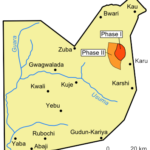
By law, a motorist just learning the driving ropes is expected to hang it on his car; near the number plate or anywhere on the bumper or fender. The “L” sign, boldly written in red, immediately warns other motorists that the driver in front is a novice and requires to be paid cautious attention.
As the Head, Media and Publicity of the Federal Road Safety Corps (FRSC), Mr. Bisi Kazeem, explained, “the driver with a vehicle bearing an L shape sign is a learner. The L shape is a sign that is expected to inform all trained drivers and vehicle owners that the driver of any vehicle carrying that shape on the bumper or fender is an amateur that has yet to go through all the learning processes of driving. Wherever the L shape is seen, all trained motorists who have learnt the ropes should drive cautiously to ensure safety of lives.”
The logic that drivers behind wheels with the L sign are not experts informs that such vehicles are rickety or low-cost, as using new and expensive vehicles could be inviting serious damage to such cars and, consequently, huge cost in repairing them.
It is, however, not uncommon to see in the big cities in Nigeria, especially in Abuja, the Federal Capital Territory, an expensive car with the L sign. Children, wives and girlfriends of the rich think nothing of honing their driving skills on big cars, even jeeps, as they probably don’t have cheap cars in their garages anyway and can easily replace anyone damaged in the learning exercise.
Daily Trust recently witnessed a lady learner driver, with the L sign conspicuously hung on the fender of her powerful British Jaguar V8 engine, seriously bash the car along the airport road in Abuja.
Owing to the concern that authorities of the FRSC and Vehicle Inspection Office attach to driving safety, a learner driver is made to undergo a preliminary driving test before he is given a Learner’s permit (DLP). A vehicle inspection officer (VIO), who wanted anonymity, explained that a would-be driver must first pass the Private Driving School test, which takes from one to three months to accomplish, depending on how fast the learner can convince the officials.
He then applies for the Learners permit, which is for three months in the first instance, and can be renewed continuously until the learners proves he is good enough for the real driver’s licence.
The official said learners hanging on the “L” sign on their vehicles must abide by certain rules and regulations, which include driving within the range of one to minimum of five and maximum of 10 kilometres.
The learner must not travel from one town to the other and must not drive on expressways. He must also always have a licensed driver, otherwise referred to as a contractor, by his side. The VIO said any government transport officer can stop and caution the learner for violating any of the above rules for safety needs.
In Abuja, the learner pays the Vehicle Inspection Office a sum of N750 to get the three-month DLP.
Learner drivers are not excluded from penalties that expert drivers are subjected to. FRSC’s Kazeem warned both learners and licensed drivers that “to safeguard the lives of both drivers and other road users, the Commission has organized mobile courts to prosecute all traffic offenders who commit offences like dangerous driving, driving under the influence of alcohol or drugs, wrongful overtaking, speed limit violation, assaulting marshal on duty, or as deemed fit by the arresting officer.
FRSC officers and marshals, he warned, would crack down on drivers of whatever status who commit such offences, as well as violate the seat belt, phone use and mechanically-deficient vehicles rules. It is actually with a view to stem the incidence of learners committing these offences that the rule stipulates they must have experts by their side once they sit behind the steering to drive.
On the long duration of three months it takes to issue a DLP, Mr. Kazeem explained that the technicality involved does not rest with the Corps alone, as the DLC production is a tripartite arrangement among the FRSC, VIOs and the states’ boards of Internal Revenue Service. It is after certain details have been taken care of at the managerial level that the issuance process will start taking effect.
He advised motorists to ensure they go to FRSC and VIO offices to collect their genuine licences. “It is as a matter of policy that the Corps placed the DLC centres in strategic locations. There are plans for expansion to remove the stress Nigerians go through to get genuine driver’s licence,” he said.
 Join Daily Trust WhatsApp Community For Quick Access To News and Happenings Around You.
Join Daily Trust WhatsApp Community For Quick Access To News and Happenings Around You.


